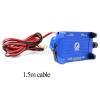I like to stop when I want to stop not when I have too for fuel.
I live in Texas so in some areas there can be a long ways between fuel supplies. I like to ride in places where fuel stations are few and far between.
If I lived in the northeast US, and only rode up there, I probably would not consider an auxiliary.
Once I get in the riding mode I don't like to stop until my body says to stop.
A 1.8 gallon auxiliary plus the stock 4.8 gal (I can get 4.9 to 5 on the right slope) on my Honda VTX1300R is enough to get me comfortably to 200 miles. I would like 300 for an IBA Gold ride.
My Yamaha Royal Star Venture S has a 5.9 gallon stock tank but 4 thirsty carbs. I bought a used 5 gallon tank mounted in place of my pillion so I could achieve 300+ miles on a fill. 5 gallons extra is overkill but nice to have extra. I purchased a new 3.5 gallon (takes less room) yet to be mounted in place of the 5 gallon. It should work just fine, especially for extended touring. For anything over a SS1000 I'll use my 5 gallon.
This was my learning curve, my experience with my prefered riding area, and personal requirements. Each person must decide for themselves.
I'm also in Texas... I completed my first ride a week ago... Last time I did 1000 miles in 24 hours it was when I was in the Navy and being transferred between bases... Let's just say that it was a lot easier 40 years ago... Getting old sucks...
My wife is in Europe for the month and I guess I was just trying to prove to myself that I wasn't OLD
yet... Not so sure how successful I was at that and I suspect I proved the exact
opposite...

I chose to do a loop ride through South Texas -- basically, Houston -> McAllen -> Laredo -> Del Rio -> San Antonio -> Houston... That way, if anything went wrong, I wasn't TOO far from home... I was concerned about gas availability also since I had never tested my Harley FLHP-I to see exactly how far it would go to COMPLETELY empty... Normally, I would just look for a gas station immediately when the low fuel light would come on, so I didn't know how many miles I could get by before it truly ran dry... So, I carried a 5g plastic gas can with me with 4g in it... Unfortunately, the vent cap on it had gone missing and the vent hole had been plugged with a Torx machine screw -- which did a great job of sealing it, but made it impossible for me to open up the vent when I needed to transfer gas from the can to my tank... Without the vent, pouring the 4g into the main tank was VERY slow... As it turned out, I was able to get 168.6 miles on the tank (after which, I need to either have a spare gas can, be sitting in front of a gas pump, or I'll be pushing it).
A cold front had come down right before the ride, so I could not use the entire range on my tank anyway... I needed to stop often and put my hands on the engine or exhaust to thaw them out... Because the route was basically a triangular loop, I needed to be concerned about whether the IBA would claim that I was cutting corners, so even it it hadn't been cold, I don't think I would have gotten much benefit out of really long fuel legs on this particular ride... As the ride progressed, I was cold, shivering, and basically having to crawl off the bike at each fuel stop... It ended up taking me 23 hours to do the 1033.7 (odometer) / 1040 (Google Maps) mile route...
I'll probably end up plumbing in an aux tank one of these days since I like the flexibility that it gives me...
So, what does a windshield look like after 1033.7 miles of South Texas bugs?

Assuming I did my calculations right, I used 30.9702 gal and had a fuel economy of 33.3772 mpg.





